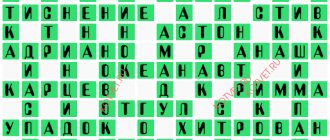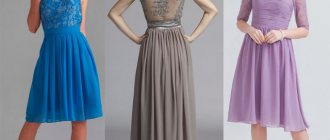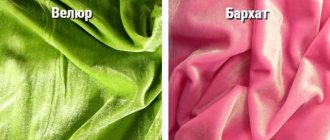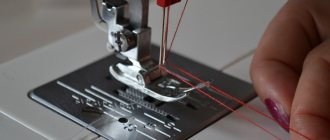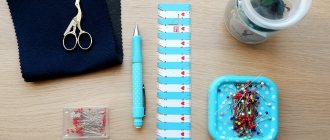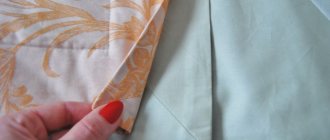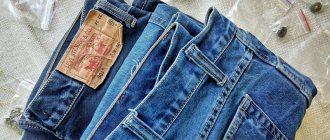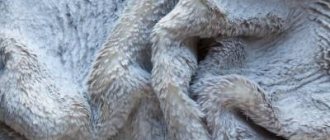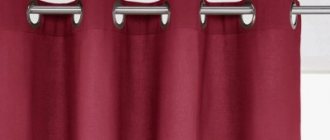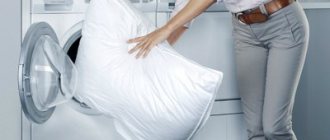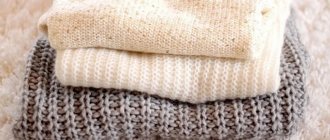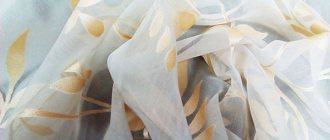Not so long ago, household machines with a stitching option were incredibly popular. The modern market offers modernized equipment with which you can process sections with high quality.
It is difficult for the average person to understand the differences in the functionality of an overlocker, a coverlocker and a cover stitching machine. When choosing a suitable option, you should focus on the technical parameters and purpose.
Question 1. What is it?
A cover machine is a type of sewing equipment that performs flat seams that cannot be performed on other types of sewing machines. Its stitches are used when sewing clothes from highly stretchable fabrics, knitwear, stretch and knitted materials. Such a machine does not have a bottom threading and the stitching on a flat-stitch machine is formed by creating a chain stitch, which has the properties of stretching when the fabric is stretched and does not tear.
When sewing, a flat-stitch machine uses two or more threads, so the number of lines it can sew can reach up to twenty. These stitches can be both practical in nature - connecting parts, performing a professional hem at the bottom, sewing on details, and finishing - being a decoration of the item, its highlight.
Also, when working on a flat stitch machine, up to three needles are used, which can be combined, adjusting the width of the seam, thereby creating different types of flat seams.
How to choose sewing equipment
There are a number of significant nuances that must be taken into account when purchasing equipment. For ease of use, a cover stitching machine must have:
- a removable platform for the ability to process hard-to-reach parts of products, such as sleeves or trouser panels;
- separate conveyors for the possibility of processing sliding and thin fabrics;
- special scales for easier orientation;
- Pressure regulator on the presser foot of the machine.
Important characteristics for a cover stitching machine are the smooth operation and noise level of the operating equipment. The more different types of stitches a machine can make, the more its cost will be. The average cost of a cover stitching machine is from 20,000 to 30,000 rubles.
Many models are equipped with a hint system that makes working with such equipment much easier. When selling products, some manufacturers include tools and kits to simplify the work, which also facilitates the process of caring for equipment. Such tools include:
- large and small screwdrivers;
- brush for removing dirt;
- mesh and spool holder.
When sewing large quantities of products, it is recommended to use threads on large bobbins, since the thread consumption when working on the machine is quite large and the use of large bobbins will significantly save time and money. The craftswoman will have to spend much less time re-threading the threads, and the cost of the bobbins is much cheaper than purchasing regular threads in the same quantity. When choosing threads, you should take into account the fact that you cannot use threads of different thicknesses for work at the same time. Otherwise, the seam will turn out to be defective, and in exceptional cases this can lead to failure of the equipment settings, which is almost impossible to correct on your own at home.
Question 2. What is a cover stitching machine for?
The name of this machine does not make it clear to the average sewing enthusiast what its intended purpose is; does it perform some unknown cover-stitching operations? And in sewing slang it’s called a flat stitch, and here a novice needlewoman can be left scratching her head, what kind of flat stitches does she make and where are they used? The answers to these questions will not be given to you in a household appliance store; the sellers there will most likely confuse you even more. To know about its purpose, it is best to contact an experienced seamstress. And since I have such an assistant at home, these questions have not puzzled me for a long time)
Firstly, a cover-stitching machine is indispensable when sewing knitwear. Its stitches are used when sewing T-shirts, T-shirts, underwear, sweatshirts, sweatshirts, long sleeves, dresses, clothes made from stretch and stretchable fabrics. If you intend to sew at least one of the listed things on a regular basis, then you definitely cannot do without a flat-seam stitch in your work.
Secondly, why knitted items cannot be sewn on a regular sewing machine. Because only a stitcher can make a knitted or, in other words, elastic seam, which stretches along with the fabric when it is pulled, without being deformed. Moreover, they may not unravel if one of the threads breaks; this is facilitated by the complex interweaving of the threads when forming the lines.
Thirdly, in addition to elastic stitches, the cover stitch can be used when sewing on lace, ribbons, and adjusting elastic.
Rating of the best manufacturers
When choosing the best cover stitch machine, it is important to consider not only its versatility, but also the brand of the manufacturer that produces it. Models from well-known popular manufacturing companies, distinguished by the consistent quality of their products, equipped with a number of useful functions, always ensure high-quality work and a long service life. Such well-known and popular brands include:
- Brother is a Japanese company, distinguished by practicality, absolute comfort and versatility in work. While developing and producing printers, faxes, and personal computers, it also produces sewing-type machines, including high-quality cover-stitching models;
- Janome is also a Japanese manufacturer specializing in the production of sewing household appliances and the production of accessories for them. The quality of its household products allows the use of the flat-stitch machines they produce even in small industrial sewing studios;
- Juki is another Japanese manufacturer that produces many sewing and stitching devices, industrial overlockers;
- Merrylock (Taiwan) is a company that produces, in addition to overlockers, only flat-stitch machines. Its products are considered to be some of the best sewing machines on the market;
- Husqvarna is a Swiss manufacturer that produces various kitchen appliances and motorcycles. In its sewing machines, this company was the first to use a system with a central bobbin, a zigzag seam and an electric drive;
- Minerva is an Austrian company that produces electric and computerized sewing devices for all price categories;
- Singer is a German sewing machine manufacturer that pioneered the use of sewing needles. The truly German quality of its products is known throughout the world.
Question 3. Do I need a cover stitcher if I have an overlocker?
If we talk briefly about the main purpose of an overlocker, it is high-quality and professional processing of cuts. Can an overlocker replace a cover stitching machine? If you have already purchased an overlocker, you can look at the instructions for it to become familiar with its functionality. Today, some models of overlockers perform flat seams and can partially replace cover stitching machines. Why partially? Because an overlocker is still an overcasting machine, even if you look at the overlocker from the side, you can immediately notice its visual difference from a cover-stitching machine - this is the length of the sleeve.
If there is practically no space left in the overlocker on the inside of the presser foot, the cover-stitching machine, due to the unreduced overhang of the sleeve, is able to connect the parts.
Pros and cons of cars
When choosing a machine, it is important to familiarize yourself with the advantages and disadvantages of each type.
Overlock
| pros | Minuses |
| high-quality edge processing; | poor equipment |
| elasticity of decorative seams; | limited functionality |
| ease of use; | |
| relatively light weight of the structure. |
Coverlock
| pros | Minuses |
| versatility; | the need to adapt to switching modes; |
| multifunctionality; | high price; |
| high quality tailoring (similar to factory); | impressive weight. |
| ability to work with different numbers of threads; | |
| good package, expanding functions. |
Question 4. What operations does a cover stitch machine perform?
In order to clearly understand which stitches the cover sewing machine makes, you can take any T-shirt and see which stitches it is sewn with.
1. The most common seam used when sewing knitwear, made with a flat-stitch machine, is a connecting one. It is used to sew down the necks of T-shirts, you can find it when connecting a sleeve to a bodice, or when finishing sportswear.
2. Wide and narrow flat seam, Flatlock. Typically, such stitches are indispensable when hemming the bottom of knitwear, as well as when sewing on a belt, especially an elastic one with an internal elastic band.
3. The possibilities of a flat-stitch machine don’t end there; you can change the positions and number of needles, as well as thread threads of different colors to get beautiful flat seams, used in sewing not only as connecting stitches, but also as finishing stitches.
Sleeve extension length
| Overlock | Coverlock | Flat stitch machine |
| The shortest. The size is due to the processing of slices only. | Medium size due to its functional versatility. | The longest. The parameters are comparable to the sleeve of a regular sewing machine. Free space provides comfort when stitching. |
You can also distinguish an overlocker by the unusual shape of the body, which does not look like ordinary machines. The opener is distinguished by the absence of a knife (it may be included in the kit as a useful addition). The coverlock not only combines the functions of opponents, but also their external outlines.
Question 5. Do I need special threads to use a cover stitching machine?
In order to get a high-quality and well-stretchable seam that will not tear, you first need to take care of the quality of the threads used in sewing. From my own experience, I can say that machines such as an overlocker, a coverlocker or a cover stitching machine are quite capricious and are sensitive to the types of threads threaded into them. Therefore, if you intend to sew something from elastic fabric, immediately purchase a set of threads of three or four pieces of the same density and preferably from the same manufacturer.
⇡#Model capabilities
This question is most acute when choosing a specific model of computer sewing machine. It is with this type of machine that the number of lines often exceeds two hundred and causes ripples in the eyes and dizziness. You don’t need to start your choice with the number of lines. There are more important parameters that you should decide on first.
1. The type of fabrics the machine is designed to work with. There are machines for working with all types of fabrics; there are models designed for light and medium, or vice versa, for medium and heavy fabrics. If you definitely know that your main area of activity will be, for example, dance dresses made of silk and chiffon, take a machine for light fabrics, it will work with them better than a universal one. If your choice is a coat and jeans, consider models for medium and heavy fabrics. Usually they have a larger gap between the foot and the needle plate, which allows you to put a thicker layer of fabric under the foot, and a more powerful motor that can sew this layer.
2. Maximum stitch length (up to 5 mm) and maximum zigzag width (up to 7 mm). The larger these parameters are, the better: it expands the field of possibilities.
3. Shuttle type: the shuttle can be vertical, with a removable bobbin case, as well as horizontal, where there is no bobbin case. The second option is more modern and reliable - it has fewer parts that can break.
4. The loop can be automatic or semi-automatic. The “full” machine allows you to make up to 7 different types of buttonholes, in one operation you can sew a buttonhole exactly to the size of the button, remember the size and repeat a buttonhole of the same size the number of times you need.
Automatic buttonhole foot
Semi-automatic buttonholes are usually performed by simpler models. Here you determine the size, guided by the markings on the foot, the loop is sewn in 4 consecutive operations. It’s not difficult and it’s not that long, but if you multiply it by 10, 20, 30 buttons per suit, the difference is quite significant.
Foot for semi-automatic buttonhole
5. Optional, but very convenient features are a built-in needle threader, the ability to sew with a double needle, a needle positioning button and a spot fastening button. If you are going to sew a lot, you should pay attention to the possibility of working without a pedal and external speed adjustment; this greatly saves your leg, which after four to five hours of continuous pressing the pedal begins to complain, and besides, the pedals fail faster than the machines themselves, and they do this, as a rule, at the most inopportune moment.
This is where the general recommendations end and all that remains is to choose from the mass of proposed lines, fonts and flowers the set that will be useful to you personally, and I will finally tell you about another very important point.
Question 6. What you need to know about the cover machine for successful sewing
1. In order for the stitches to be of high quality and the threads not to break, you will first need to understand the thread tension regulators, which are located on the front of the machine. Each type of seam will have its own settings, and they will not necessarily coincide with those recommended in the instructions. You will have to first make stitches on a fabric sample, achieve a high-quality seam, and only then move on to the product itself.
2. Also on the cover sewing machine, in addition to the thread tension regulators, there are other settings, namely:
- Presser foot pressure regulator on fabric; it is used when working with fabrics of different thicknesses and densities. This setting can also be used to obtain wavy stitches.
- stitch length regulator.
3. To work with a cover stitch machine, you do not need special needles; you can use the same needles that you use on your sewing machine. But at the same time, you need to make sure that there are no burrs on the needles, that they are sharp, this is especially true when you often sew on tailor’s pins. You need to change them in time, otherwise you won’t understand what the problem is when your flat-seam suddenly stops making a stitch, and the problem will be a dull needle)
⇡#Types of sewing machines
All sewing machines are divided into industrial and household. Usually a household one can do a lot of things at once, and an industrial one can do one thing - but it can do this one thing very well and for days, years, kilometers - without breaking down. At least that's the idea.
However, industrial machines are unlikely to interest you, unless you intend to open a small sewing enterprise - they are very expensive, bulky and noisy in operation - so in this material we will concentrate on household ones. Household machines are divided into:
- electromechanical,
- computer,
- sewing and embroidery
- embroidery,
- overlockers,
- cover,
- carpetlocks.
What does all this mean, and which category should you choose?
1. Electromechanical sewing machines are the simplest of all. The entire internal filling of such a machine is mechanics, that is, levers, shafts and gears. Only the motor that drives it all is electric.
Example - Minerva M832B:
- 32 types of stitches
- semi-automatic loop
- vertical shuttle
- stitch length 4 mm
- stitch width 5 mm
The undoubted advantages of this type are reliability, low price, and inexpensive repairs in case of breakdown. Conventional electromechanical machines are inferior to computer machines in the speed of operation and number of functions, since the technological design features do not allow for stitching of complex shapes, but are perfect for beginning seamstresses, or those who want to have a reliable assistant for small household needs. However, a coat, jeans, and a ball gown are quite capable of a good and properly adjusted electromechanical machine. The approximate price category of such machines is 3–5 thousand rubles. Simple, affordable, reliable.
2. Computer sewing machines are distinguished by the presence of a computer board that provides overall control of the process, which allows this type of machine to carry out quite intricate stitch programs. The movement of the needle relative to the fabric is controlled by a microprocessor. What a particular model can do depends on the amount of memory and the number of programs of this machine “brain”.
Example - Minerva DecorExpert:
- 197 types of operations
- automatic loop
- horizontal shuttle
- stitch length 4.5 mm
- stitch width 7 mm
Their starting price is approximately two to three times higher than the price of electromechanical ones. At first glance, the huge number of stitch types seems to be an undoubted advantage. These include 15 types of different loops, and chains of different flowers and leaves, and a dozen overlock stitches, and knitted seams. But take a closer look at this list and think about which ones will you personally actually use? It turns out that you don’t need some of it at all, and some of it is just numerous duplicates of the same thing with minor deviations.
Personally, I regularly use six or seven of the 56 stitches I have in my machine, and use two more from time to time. However, one cannot help but notice that this already greatly expands my capabilities in comparison with working on an electromechanical sewing machine. So don’t be tempted by the excess of functions - it’s not at all a fact that you will need all of them. Or rather, the fact is that you are unlikely to ever try many of them.
Several types of overlock stitches, a knitted stitch, a triple reinforced stitch, a knitted loop and a loop with an eye will be useful in your work - in addition to the regular loop, of course. The rest of the features are up to you, just don’t let the variety go to your head. It's a shame to pay extra money for something you will never use.
The undoubted advantage of a well-functioning computer machine is the speed and accuracy of its work. If your plans include kilometers of frills and sewing to order for 8 hours a day, a computer machine will significantly save you time and give you additional opportunities for creativity. A buttonhole with an eye is, of course, a small thing, but this little thing affects the entire look of the coat.
The disadvantages are the high price, capriciousness in setting up, and repairs, if something happens, more expensive.
3. Sewing and embroidery machines . Everything is simple here, unlike industrial embroidery machines, which can, in fact, only embroider; such combines often combine two functions.
In my personal opinion, budget versions of sewing and embroidery machines combine these functions very poorly. They are too capricious compared to regular sewing machines, and compared to full-fledged embroidery machines, they are too limited in embroidery capabilities. And more expensive models are also scary in price. Therefore, I recommend considering this class of machines exclusively as embroidery machines and purchasing them based on these purposes.
Also, don’t think that if you buy an embroidery machine for 100-300 thousand, you will immediately create a masterpiece. Embroidery on a sewing machine is also an art that needs to be learned. In courses or independently, using books or online lessons. In general, working with it is somewhat reminiscent of working in Photoshop. You can go to a specialized website, type in motifs drawn by someone there, quickly read the instructions and glue them together as best you can, adding stars and hearts with a stamp. But if you look at the masterpieces created by professionals, it becomes clear that this is not even a third of the capabilities of this tool.
So, think carefully about whether you need this, and to be honest, in most cases it is much easier and incomparably cheaper to order embroidery from a workshop that already has serious equipment and a good craftsman. Outsourcing is everything to us. Personally, this is what I usually do.
4. Coverstitch sewing machines . They are also flat-seam machines .
Designed to make an elastic flat seam used to close the hem edge of a knitted product. This whole complex verbal construction refers to that seam that you can see on the hem and sleeves of almost any T-shirt.
Among household machines, flat stitches can be made by two types: flat stitch machines and carpet lockers. A regular stitch looks the same on both the front and back sides, as the top thread is wrapped around the bottom thread (bobbin) and tightened. A flat or chain stitch looks different. It is obtained by simultaneous operation of two or more needles and loopers.
This type of sewing machine is designed to work with elastic “stretch” fabrics. If your main goal is T-shirts, swimsuits and tracksuits, this is your choice. Price category from 10–15 thousand.
5. An overlock is a machine with one or two needles, equipped with a trimming mechanism and designed for overcasting the edges of a wide variety of garments. When choosing an overlocker, you should first of all focus on ease of threading and sewing. We should also not forget about the possibility of overcasting with different numbers of threads. Most overlockers perform 3- and 4-thread overcasting, suitable for most types of fabrics, and rolled edge overcasting. On higher-end overlockers there is a 2-thread overlock designed for the finest fabrics - such as silk or chiffon - as well as for decorative finishing.
In principle, overlocking functions are also available in computer sewing machines. But a seam made with a real overlocker is much more accurate and reliable. In addition, the overlocker is equipped with knives that themselves cut off the excess allowance, leveling the edge, which significantly saves time. In general, if you sew regularly and the free space allows you to place two units, an overlocker will be a very useful acquisition, but if not, you can do without it. In any case, it does not replace a sewing machine, but only complements it. It is not intended for assembling product parts. The price for overlockers starts from 6 - 7 thousand, for 10 you can buy a quite decent model.
6. Coverlock is a relatively new invention that many are not particularly familiar with. Pfaff marketers came up with this name for their range of such machines and patented it, after which it firmly entered into everyday use. It combines the word “overlock” and the English term coverstitch, that is, “covering” or “closing” stitch. This machine can perform both overcasting of garments, and flat seams and straight chain stitch, that is, it combines an overlock and a flat stitch machine. The price for carpet locks is quite high and starts from 25–30 thousand.
Like a cover sewing machine, a carpet locker is designed to work with knitwear. The design also assumes the presence of several (from 2 to 10) upper threads and loopers, with the help of which you can create various, sometimes very complex seams, indistinguishable from industrial ones.
What to choose for working with knitwear - a carpet locker or a pair of overlockers plus a cover-stitching machine? On the one hand, a carpet locker has a larger number of loopers, which allows you to make more complex seams; it alone takes up much less space, and its high price is quite comparable to the total cost of a cover stitcher and an overlocker. On the other hand, when processing a garment, you may first need an overlock, then a flat seam, again an overlock, again a flat seam, and so on every five minutes.
In the case of two machines, this will not present any difficulty, and each time the carpet lock will have to be reconfigured from a flat seam to an overcast or overcast stitch and back. And this is a rather long and painstaking process, which even with skill takes several minutes. It's up to you to decide what's more convenient.
Question 7. With what set of functions is it better to choose a cover maker?
The quality of work depends on how many more functions your machine will perform, so it is important to pay close attention to this stage. But you also shouldn’t buy a cover maker with an excessive set of functions that can increase its cost and be absolutely useless in operation. A flat-stitch machine must contain:
- removable sleeve platform;
- speed not lower than – 1000 stitches/min.;
- if the machine has a thread tension control system in the looper, you will not have to adjust the settings yourself each time;
- the number of needles is at least 3, then you can make a larger number of seams;
- automatic needle threading means that the machine itself will rethread the threads for you and pass them through numerous loopers on its own, which of course saves time and sometimes nerves for a novice seamstress. I’ll tell you from experience, for me, threading needles is my least favorite sewing operation)
- the number of sewing operations is from 4 or more. The most expensive models of cover stitching machines can perform up to 20 types of seams.
Functional differences
| Type of machine | Functional | Trimming | Stitching | Flat seam |
| Overlock | overcasting | + | + | — |
| Coverlock | overcasting flat-seam | + | + | + |
| Rasposhivalka | flat-seam | — | — | + |
On the technical side, the following differences are noted:
- Difficulty to use – an overlocker is considered the easiest to use; a cover-stitching machine is also easy to get used to; a carpetlocker requires more time to acquire skills;
- spools - overcasting and coverstitching machines can work with 2-5 threads, for a carpetlock the number reaches 10;
- loopers – the overlocker has 2 of them, the coverlocker has 3, the cover stitcher has 1;
- method of rethreading threads - the threading diagram is indicated on the body of the structure, some models are equipped with an automatic rethreading option;
- knife – available as the main element of overcasting equipment and carpet lockers; some models of cover stitch machines are equipped with removable knives, but it is not included in the standard structural parts.
Reference! A special feature of carpet lockers is that they are equipped with additional useful options.
The sewing devices in question do not have a bobbin. A looper is used instead.
Its function is to capture the upper needle thread for further tying it with the lower thread. If you have a knife, it is necessary to promptly remove scraps of fabric and thread. If they get inside the housing, the loopers may break.
Question 8. What is the difference between a household cover stitch machine and an industrial one?
In a sewing store they can show you such a unit as an industrial sewing machine, how does it differ from a household one? Firstly, you can visually notice that it is not sold separately, but comes complete with the table. Moreover, it is firmly built into it, this is done in order to eliminate unnecessary vibration, because its operating speed is tens of times higher than that of its everyday counterpart. Secondly, to operate an industrial machine, you need a powerful engine, a motor and an electric drive with two pedals, the first of which raises the presser foot, the second starts the sewing mechanism.
Of course, such an industrial machine can sew much larger volumes of clothing and perform a larger number of seams, since it uses up to 8 needles. But if you are not going to launch mass production of knitted clothing, a household flat-seam stitcher will be enough for you.
Main selection criteria
Before choosing a cover stitch machine, it is advisable to familiarize yourself with all its main and additional functions. Have a clear idea of what kind of work you need it for. When choosing it, it is best to be guided by the following criteria that determine the characteristics of the cover maker.
Device power
As well as its performance, weight, which can range from 5 to 15 kg depending on the availability of various accessories and auxiliary tools. The operating power of these devices can be on the order of 70 to 250 W, depending on the installed electric motor. The greater the power of the device, the higher its productivity, which is determined by the sewing speed over a certain time period, for example, 1000 stitches/minute.
The higher the power, the higher the performance
Platform
And a separation conveyor, which comes with sewing equipment for processing individual elements. The conveyor prevents distortion of the stitches when sewing, stretching and tightening the fabric according to the selected mode. The presence of platforms facilitates high-quality stitching of the lower parts of sleeves, collars, and lapels.
They can be of different types:
- removable, flat platforms, for processing lower closed and open cuts, turning with bias tape;
- platforms that have a recess for the edging to obtain high-quality edging of soft products with bias tape;
- cylindrical platforms, solid or with a special recess, are used for turning long or narrow parts and for sewing children's underwear.
Interesting! Separate feeders can help gather or stretch sliding fabrics to create beautiful pleats or gathers.
Working distance between outer needles
Determines the required width to obtain the desired stitch. The standard value of this width is usually 5.5 and 6.5 mm, so machines are divided into:
- for 2 needles (seam width 5.5 mm) with three threads, perform the same type of stitches;
- for 3 needles (seam width 6.5 mm) with four threads, can make several different seams;
- for 1 needle with two threads, used for making regular seams.
Types of flat seams
Household cover stitchers perform four types of seams:
- triple, 5.6 mm wide;
- wide, 5.6 mm wide;
- narrow left-hand position, width 2.8 mm;
- narrow right-hand position, width 2.8 mm.
Automatic refueling mode
It is used for threading into the eye of a needle (as a rule, expensive models of stitchers are equipped with this mode).
Thread tension
There are two types of flat-seam devices:
- Manual adjustment, in which the tension force of all threads can be different, so this option for adjusting the tension requires special dexterity, skill, and a good eye;
- The automatic type of tension makes the sewing process quite simple, minimizing possible sewing errors.
Fabric feed type
Differential types are often used in cover stitchers:
- Automatic mode (when front and rear conveyors usually feed fabric at a constant speed);
- Manual mode (when, if necessary, the speed is partially changed manually for only one conveyor, which makes it possible to stretch the web or create folds).
Question 9. Price for a flat-stitch machine?
If you decide that you cannot do without a cover machine when sewing, the question immediately arises - how much will it cost to purchase this equipment. In fact, a cover sewing machine is a budget sewing equipment; prices for it start from 15 thousand rubles, that is, it will cost you the same amount as a household overlocker. And if you already have an overcasting machine at home, then a flat-stitch machine will be a good addition to an overlocker. You won't have to take a carpetlocker, and you won't have problems rethreading or rearranging needles.
Question 10. Where can I buy a cover stitching machine?
Now that you know what functions of a cover stitching machine you need for your work, you can start choosing a model from the manufacturer. Today this can be done in three well-known ways.
1. Internet . Honestly, this is my favorite shopping option, what's so good about it? There is no hustle and bustle of buyers here, I can calmly go to a website that sells sewing equipment and leisurely make a choice. And if I doubt a purchase, I can read customer reviews. Also online you can always compare prices from different online stores and choose the best price.
2. Offline . When I have already made a choice and I want to touch the machine and make test stitches on it, I simply go to a sewing store to test the stitcher in action. The downside here is that you have to spend time, so it’s worth asking the store if they offer a trial period when buying a sewing machine online.
3. Websites for used equipment . Here I mean such as Avito, From Hand to Hand and so on. Sometimes in the vastness of these flea markets you can find really worthwhile equipment at a low price. But in order not to buy a pig in a poke, if you have no experience in sewing, it is best to take with you to the transaction a person who knows a little about sewing equipment.
Is it difficult to learn to sew on a stitcher?
It is believed that the stitching machine is “capricious”, but if you master it, you can easily sew on your own with flat stitches, which will not differ in any way from the factory ones. Threading and all other operations are practically no different from operations in other types of machines. There is one recommendation: if a person does not have an overlocker and has not worked on it, then it is too early to think about a cover stitcher. You can kill two birds with one stone by purchasing a carpet locker, which can also make flat seams, albeit not of the same quality as a cover stitcher.
Cover stitch
A cover sewing machine is a useful device for performing a narrow type of work. It allows you to do something that other types of machines cannot - create high quality flat seams. Even inexpensive options will allow you to hem the bottoms and sleeves of T-shirts or shirts without much effort.
Sewing life hack for those who don’t yet have a sewing machine
If you need to make a stitch on knitwear, for example, in order to hem the bottom of a T-shirt or sleeve, you don’t have to go to the studio for this service.
An imitation of a flat seam with two lines can be done on a regular sewing machine that has a zigzag function; for this you will need a double (double-rod) needle. The difference in sewing this way is that two threads will be threaded on top, and when sewing, the machine will make two parallel lines on the front side, and one zigzag on the back.
Topstitcher or carpetlocker?
Is it better to buy a cover stitcher or a carpet locker? Both the cover stitcher and the carpet locker are very necessary and good machines in their own way, but there are not as many models of flat-stitch household machines as coverlockers. Maybe because a carpet lock is still more convenient, and most importantly more functional and practical for use at home. But if you are of the opinion that a bicycle will not become a motorcycle, even if you attach a motor to it, then buy a cover rack “in its pure form.” It has a longer sleeve reach, a more spacious table and fewer bells and whistles, which accordingly reduces the price. So, for example, the average price of a household cover is around 15 thousand rubles, and there are carpet covers for fifty thousand. In addition, the cover maker will be used less often, only when necessary, and therefore will last longer.
One of the most important parameters of the cover stitch is the width between the outer needles; this value can be 5.5 or 6.5. If you need a 5.5 seam, choose a 2-needle cover stitch. Cover stitch machines with a value of 6.5 also have a middle needle, i.e. These machines are 3-needle. In 3-needle machines, you can get several types of cover stitches, in contrast to 2-needle machines. Instead of 3 needles, you can install only two extreme ones, or the central and extreme left, central and extreme right. In a word, the main difference between a household flat-stitch machine is the number of needles and threads. If the stitcher has 2 needles, then it works on 3 threads; if it has 3 needles, then it works on 4 threads.
